2024 Channel and Partner Marketing Trends and Challenges

Posted on: March 1st, 2024
How to accomplish strategic channel enablement and marketing goals in 2024 with scale, efficiency, and ease.
In our ongoing commitment to help channel, partner, and alliance marketing professionals understand the dynamic landscape of channel marketing, Merit Mile conducted a survey in January 2024 to delve into the trends, challenges, and opportunities shaping 2024 marketing strategies. The report looked at key facets of the channel marketing landscape, including:
- How partner marketing budgets are being used
- The challenges faced within channel and partner marketing
- How AI is being used by marketers
- How marketers are achieving scale and efficiency
Methodology
Hundreds of organic responses were gathered from a range of marketing professionals, ensuring a comprehensive understanding of the channel marketing ecosystem. The breakdown of respondents with channel-focused organizations included:

What’s In Your Wallet?
There is no way around it, marketing requires money, so looking at budgets was a natural place to start. When marketing professionals were asked about the sources of their 2024 channel, partner, and alliance marketing budgets, there was an even distribution of funding sources. 34% indicated that their budget is sourced from partners or vendors as part of a formal MDF or co-op program. Another 33% reported partner contributions on a case-by-case basis. And 34% stated that their budget is internally sourced from their organization’s broader marketing or channel budget. As is often the case, the complete picture of a marketing budget is a combination of all three sources.
In terms of how budgets compared year over year, there was also a relatively equal distribution. 36% reported a flat year-over-year budget, while 33% experienced a decrease, and 31% enjoyed an increase.
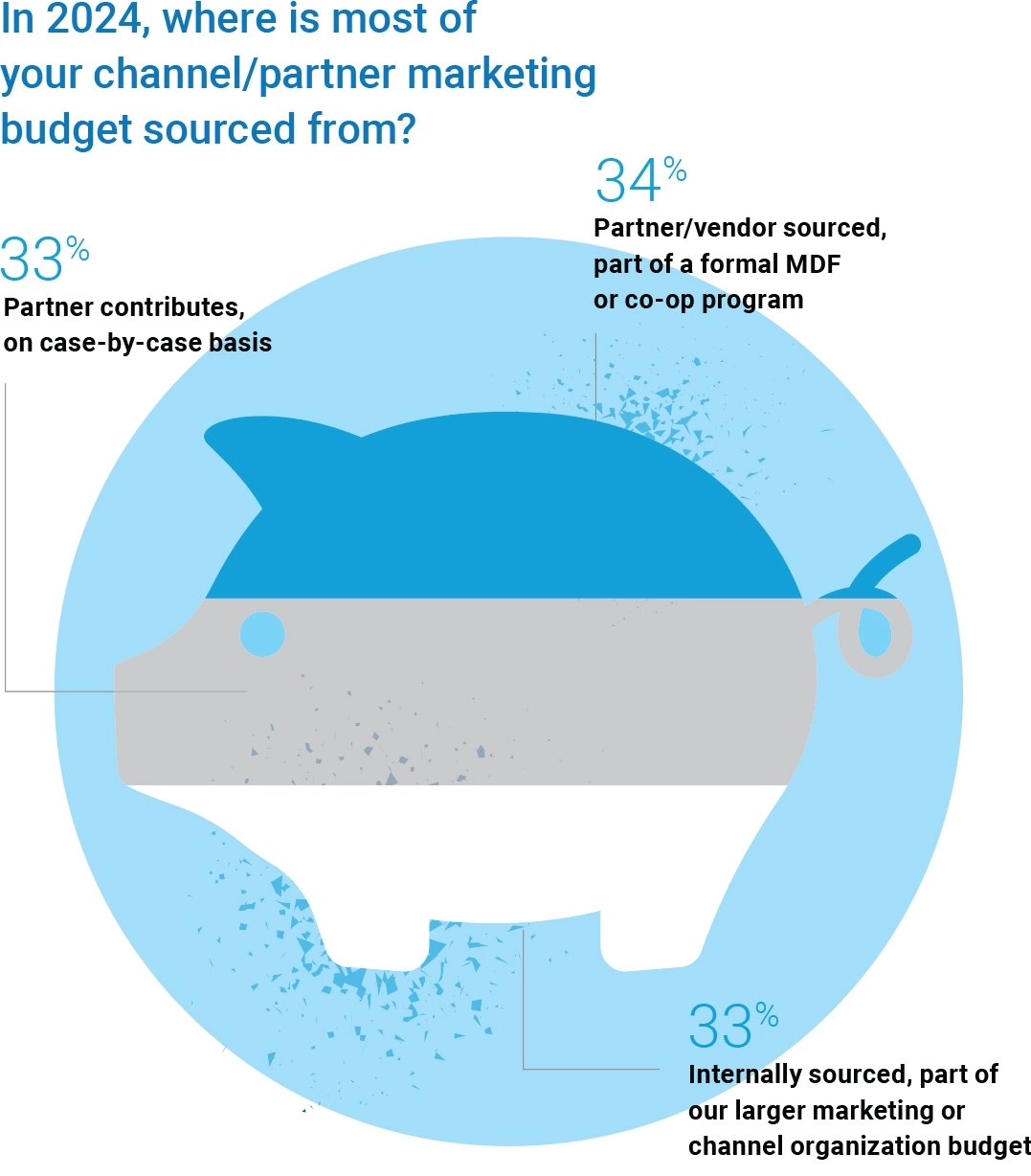
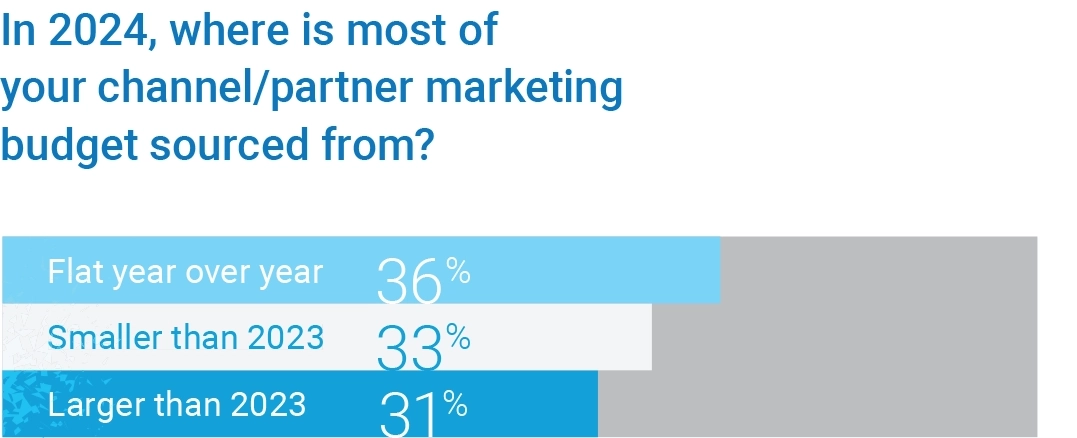
Following the Money
As for the strategic allocation of partner marketing budgets in 2024, three intertwined priorities clearly emerged in enablement, content marketing, and demand generation. The foremost focus lies on sales and partner enablement, constituting 18% of budget allocation. This emphasis reflects a commitment to empowering partners with the necessary tools and knowledge for effective co-selling. In close succession, developing assets for content marketing such as thought leadership eBooks, whitepapers, and guides is predicted to claim 17% of budgets, demonstrating a dedicated investment in co-marketing, nurture marketing, and equipping partners with ready-to-go marketing materials. Closely tied, demand generation campaigns including account-based marketing (ABM), content syndication, and nurture marketing is anticipated to secure 16% of the budgets, affirming a deliberate effort to help partners run campaigns, develop leads, and grow pipelines.
Tied for 4th and 5th place at 15% are partner recruitment and onboarding and launching solutions and services into cloud marketplaces. These strategic moves indicate a forward-looking approach to expanding and strengthening partner networks and tapping into platforms like Azure, AWS, and Google Cloud marketplaces. Conversely, a shift in strategy is evident towards the bottom of the priority list where event budgets are down, garnering only a small portion of marketing budgets.
In summary, channel marketers are demonstrating a strategic approach to budget allocation, with a clear focus on measurable and scalable programs. The spotlight is on enabling channel partners through co-selling initiatives,robust training, and building pipelines with demand generation campaigns.
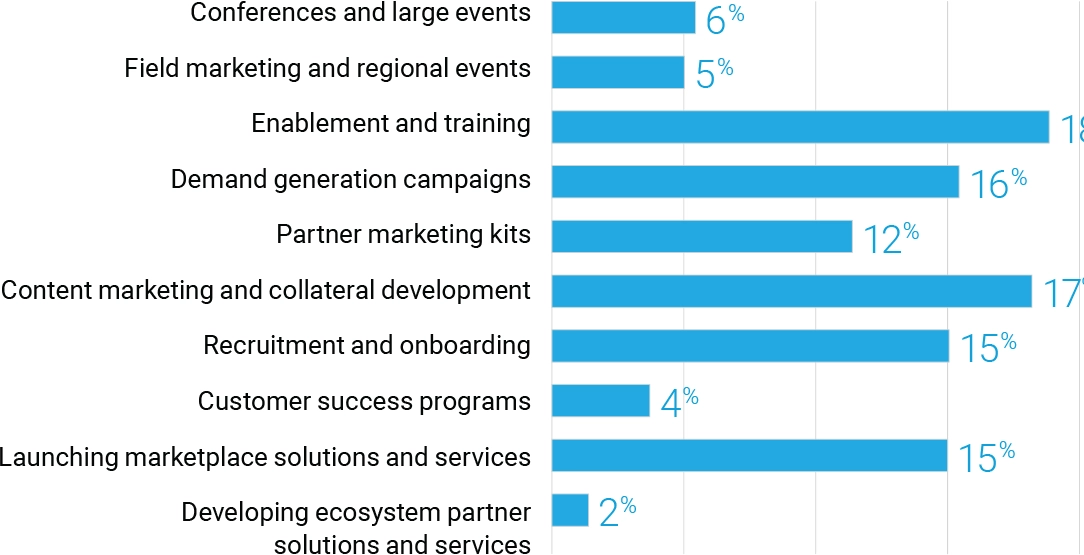
Merit Mile in Action: Azure Marketplace Solutions

The Microsoft Azure and AppSource Marketplaces provide customers with easy access to ready-to-go solutions and services. For Microsoft partners, it’s a highly visible way to promote their offerings, drive sales and Azure consumption, and strengthen their relationship with Microsoft. When Microsoft wanted to advance the number of partners with a marketplace solution, they teamed with Merit Mile to lead the effort and work directly with twenty Microsoft partners across the US, UK, and Canada.
Challenges Ahead
Despite the emphasis and investments in partner enablement, content development, and campaigns, channel and alliance marketers encounter several challenges on the road to partner marketing success. The foremost challenge, cited by 36% of marketing professionals, is enhancing the effectiveness of co-selling through partner enablement and training. The challenge lies in educating partner sales teams, including account managers, sales engineers, solution architects, and sales development representatives (SDRs) on how to effectively co-sell, position joint solutions, identify opportunities, and strategically position solutions against competitors.
The second significant challenge, reported by 34%, is gaining access to their channel or alliance marketing counterparts on the other side of the partnership. This involves navigating the landscape of partnership dynamics, understanding who to collaborate with, and securing the time and attention of counterparts. Closely tied for the third position, 29% of respondents said securing budgets and resources was their top challenge. Considering the flat and declining nature of marketing budgets covered earlier, this underscores the importance of having a partner marketing plan that ties to high-value and measurable revenue driving programs.
Nearly tied at 28%, a lack of internal creative resources to produce marketing content, design marketing campaigns, and build sales enablement materials is a major inhibitor. Given the pattern of reductions in marketing and creative staff that the industry saw during 2023, marketers are hamstrung with their ability to put ideas and plans into action.
Merit Mile in Action: Sales Enablement

When Genzeon, an established solutions provider, wanted to expand the services and solutions they offered, they became a Microsoft Cloud Solution Provider (CSP) within the Microsoft AI Cloud Parter Program; formerly known as the Microsoft Partner Network. However, their sellers were unfamiliar with selling Microsoft AI and Azure services, and they needed help positioning and demonstrating the relevance and integration of their existing portfolio. Genzeon sought our expertise to navigate these challenges and develop a sales enablement program and training curriculum. Merit Mile helped Genzeon emerge with an understanding of their role as a Microsoft partner, a clear grasp of the solutions they would be selling, and a readiness to engage with customers confidently.
What are the biggest challenges you face executing partner marketing plans?
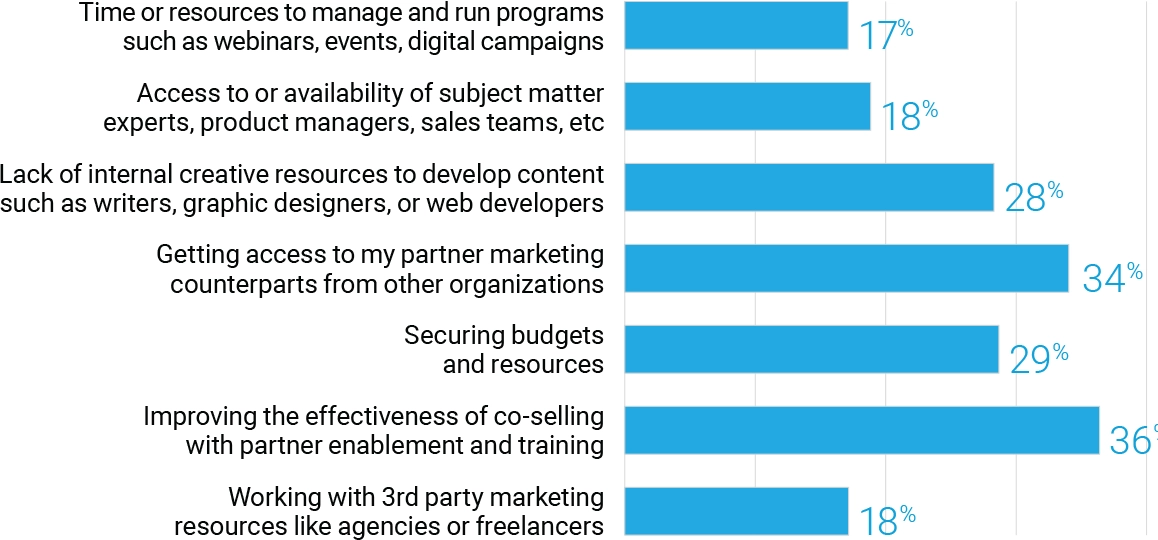
Individual Partners Struggle Even More
The previous question looked at the challenges from the partner program side of the equation, that is the organization that owns the partner program. Next, we looked at the hurdles that the individual partners face inside their own organization. In particular, the research studies the challenges partners face when utilizing vendor-provided marketing content, campaigns, and resources, such as co-brandable content, marketing kits, and campaigns-in-a-box.
At 43%, the primary challenge faced by partner marketing teams is the optimization of content and campaign performance. Despite the efforts to develop easy to use campaigns-in-a-box and turnkey kits, partners often struggle to fully utilize, customize, and optimize these materials. Achieving optimal campaign results requires ongoing customization, A/B testing, and refinement of messages, offers, audience targeting, and media placements.
This ties directly into the number two challenge, that 37% felt that partners lack a modern marketing stack of tools and platforms needed to fully execute and optimize campaigns. This highlights a critical gap in the infrastructure needed for partners to effectively implement and manage campaigns. Tools and platforms of course require people, and 31% identified that partners often lack the necessary marketing staff to execute campaigns. This constraint, tied to the challenge of gaining access to partner marketing counterparts, underscores the importance of addressing organizational and resource limitations.
Finally, the fourth biggest challenge at 27% was the customization of content for co-branding, modification of joint value propositions, changing calls-to-action, and personalizing content. Even seemingly simple customizations become challenging for partners, emphasizing the need for streamlined processes and accessible tools.
In essence, the research reveals a common scenario where marketing teams develop impressive partner marketing campaigns, yet partners struggle to fully leverage, customize, and optimize these valuable resources and use them to their full potential.
Merit Mile’s Approach to Making Partner Marketing Kits Easy to Use

Merit Mile has encountered these challenges when building partner marketing campaigns and kits for global companies like Citrix, Google Cloud, and Microsoft. Recognizing that not all marketing teams have access to the full set of design tools for creative editing, we’ve devised an approach that makes it easy for partners to customize marketing kits without expensive design software. This ensures partners can personalize content while vendors maintain creative control over the core content, ensuring consistency in messaging and brand representation.
Check out this simple and no-cost approach.
How is AI Being Used in Marketing
The advent of generative AI solutions has unleashed a wave of possibilities in the marketing landscape. While these technologies hold undeniable power and potential, it’s crucial to understand their current role and limitations. The research indicates that 41% of marketers are leveraging AI for short-format writing, including emails, blog posts, and social media content. Additionally, 30% use AI for basic graphic design tasks such as image creation and co-branding.
Marketing Professionals Remain Central to the Equation
Despite the rise of AI capabilities, it is important to note that AI is not a replacement for subject matter experts creating deep and meaningful content. The survey results reveal that AI currently accounts for only 5% of marketing content and campaign development
The majority of marketing content and campaigns are still being developed by in-house creative teams (30%) and external resources (41%). The latter category includes a mix of external contributors such as marketing agencies (24%), freelancers (12%), and contractors (5%).
While AI plays a vital role in certain aspects of marketing, the human touch and expertise of marketing professionals, both in-house and external, remain indispensable. As the industry evolves, a harmonious collaboration between AI-driven tools and human creativity continues to shape the future of marketing.
How is your marketing organization using AI?
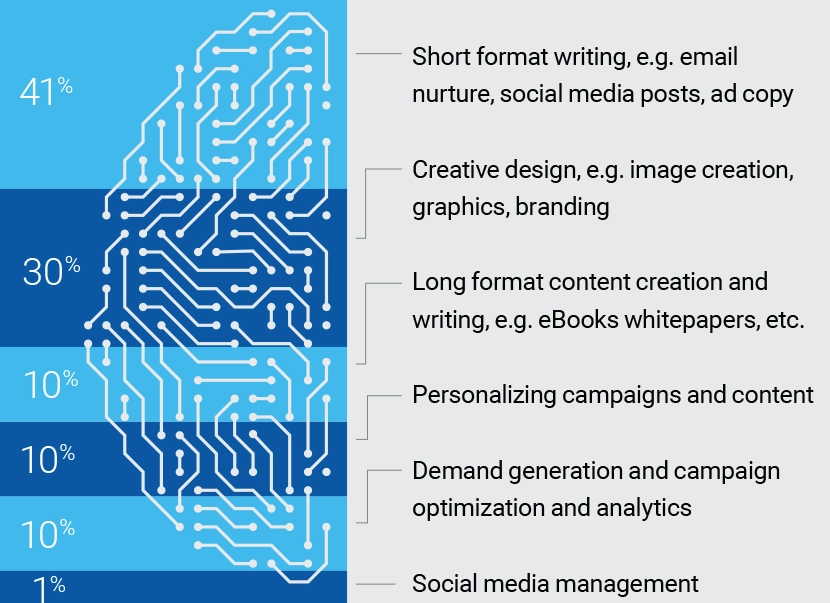
Who develops your marketing content and campaigns?
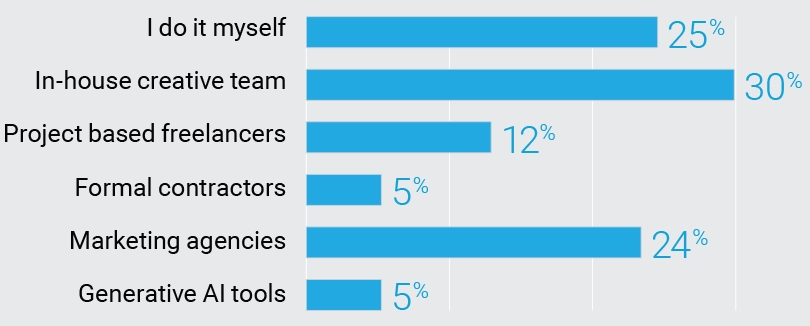
Getting By with a Little Help from My Friends
As marketing professionals navigate the complex landscape of channel marketing, the role of external support becomes increasingly crucial. Just as the Beatles famously sang, “I get by with a little help from my friends”, marketing professionals recognize the value of working with their friends, including marketing agencies and freelancers. The research shows that marketers heavily rely on external support for various aspects of their marketing programs, content development, and campaigns. Understanding the challenges they face internally, it’s clear why seeking outside expertise is a strategic move. The top four areas where organizations seek assistance include developing marketing strategies, plans, and ideas; creating content, event marketing, and building or executing campaigns.

The Payoff is Big
The benefits of collaborating with marketing agencies are evident, resulting in scale, efficiency, fresh ideas, and ultimately better results. When partnering with a marketing agency, organizations gain access to an entire team of professionals, including marketing strategists, creative designers, writers, developers, and project managers. This expanded skill set allows for a comprehensive approach to campaign planning and execution. Organizations working with marketing agencies report a range of positive outcomes:
- Stronger and more compelling content (32%): Agencies bring expertise and reativity that enhances the quality of content beyond what organizations can develop internally.
- Independent perspectives, new ideas, and fresh approaches (30%): The diverse experiences of agencies across industries provide a unique advantage in generating innovative and effective marketing approaches.
- Higher quality marketing leads (23.3%): The collaboration with agencies results in leads of superior quality and campaigns that are better managed.
- More optimal use of budget (19.4%): Agencies contribute to budget optimization, ensuring resources are utilized efficiently because performance and results are on the line.
- Faster execution of projects (16.5%): The agility and expertise of agencies enable the swift execution of marketing initiatives; far faster than internal teams can accomplish.
- Improved time management and productivity (14.6%): Organizations benefit from agencies’ support in accomplishing more within the same timeframe, effectively utilizing their time.
In summary, the survey underscores the value of partnering with marketing agencies and third-party contributors. The collaborative approach not only addresses challenges but also brings about enhanced creativity, efficiency, and measurable results.
Make Every Dollar Count, Optimize Every Hour of Your Day
In the ever-evolving landscape of channel and alliance-driven companies, the commitment to partners and channel programs stands strong. Prioritizing enablement, training, content marketing, and demand generation/ ABM reflects a strategic focus on empowering channel partners for mutual success. However, executing these priorities is no small feat.
The intersection of AI with marketing initiatives brings promise, but it’s clear that AI serves as an aid rather than a full-time replacement for the irreplaceable human touch. People remain central to the equation, and in a world where time is limited and resources are scarce, particularly on the partner side, there are challenges to overcome. The survey’s key findings underscore a pivotal truth: achieving partner marketing goals requires a delicate balance of scale, efficiency, and proper resources. The recognition that working smarter, not harder, is the key to success prompts smart marketers to seek outside help.
As channel professionals navigate the complex landscape of 2024 and beyond, the insights provided in this report serve as a compass, guiding them toward effective strategies, efficient execution, and the leveraging of external resources for optimal results. The journey toward successful partner marketing is ongoing, and with the right insights and strategic partnerships, marketers can navigate the challenges and capitalize on the opportunities that lie ahead.